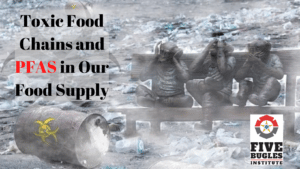Toxic Food Chains and PFAS in Our Food Supply

Medical experts have asserted for years that a healthy diet is key to a long and healthy life. People worldwide work daily to maintain a proper diet, make the right choices, and strike a balance with regular exercise to stay healthy and productive. At the same time, farmers worldwide work tirelessly to cultivate their lands for crops and livestock to provide the best products to consumers. But all of these efforts are being thwarted by 4 simple letters – PFAS.
Our previous articles in this series described how PFAS (per- or poly-fluoroalkyl substances) enters the environment, exposing plants, animals, and people to PFAS. From these environmental sources, PFAS permeates the food chain at every link, as below:
- Air, water, and soil are contaminated with PFAS from many sources.
- Plants absorb chemical contaminants from air, water, and soil, concentrating PFAS in the plants.
- Contaminated water is used to irrigate crops grown in contaminated soil.
- Animals breathe contaminated air and consume contaminated water and plants.
- People breathe contaminated air and consume contaminated water, crops, and animals.
- People and animals excrete contaminated waste (urine and stool) which becomes biomass fertilizer or is disposed of as sewage, re-contaminating water, and soil.
 Using PFAS-contaminated water to water plants or crops introduces PFAS into our soil. The roots of the plants or crops take up the water to help them grow. At the same time, those chemicals enter the plant. Those chemicals are ingested when crops are harvested and used to feed humans or animals. PFAS from this toxic food chain builds up over time in plants, animals, and humans. This process, known as bioaccumulation, leads to significant health problems.
Using PFAS-contaminated water to water plants or crops introduces PFAS into our soil. The roots of the plants or crops take up the water to help them grow. At the same time, those chemicals enter the plant. Those chemicals are ingested when crops are harvested and used to feed humans or animals. PFAS from this toxic food chain builds up over time in plants, animals, and humans. This process, known as bioaccumulation, leads to significant health problems.
PFAS contamination of farmlands has devastating results. The scientific literature cites multiple instances in which farmers and rangers have had to cull entire herds because of PFAS bioaccumulation. In one example from a 2022 scientific journal, multiple PFAS compounds were identified in the milk of a dairy farm. The PFAS source was traced back to a neighboring site, which spread contamination to the farm. Tragically, the entire herd of cattle had to be destroyed, along with the 15,000 gallons of milk per day produced by the cows until they could be euthanized.
In addition to contaminating food, PFAS directly impacts plant and animal growth and the nutritional quality of food. Once in the soil, PFAS increases the pH levels of the soil, affecting the nutrients available for plants to absorb. As a result, plants and crops grown in PFAS-contaminated soil do not mature properly and are not as nutritious. Scientists have discovered that there are places near chemical plants where fish and other animals no longer breed. Initial studies suggest this, too, can be linked to PFAS chemicals. Shrinking populations of healthy animals lower in the food chain also have long-lasting and detrimental effects on the entire habitat, threatening the food supply chain essential for survival of predatory animals.
 Another route by which PFAS enters our food is through nonstick coatings of cookware. During the cooking process, PFAS contaminates food in two ways. The first is nonstick coating scraped off the pan and other cookware during everyday use, causing flakes of PFAS-laden nonstick coating to incorporate into the cooking food. Secondly, when nonstick pots and pans overheat, PFAS leaches from the coating into the food. Nonstick cookware has a cooking temperature limit of 500'F to 550'F, temperatures easily achieved with residential or commercial cooktops, ovens, and ranges.
Another route by which PFAS enters our food is through nonstick coatings of cookware. During the cooking process, PFAS contaminates food in two ways. The first is nonstick coating scraped off the pan and other cookware during everyday use, causing flakes of PFAS-laden nonstick coating to incorporate into the cooking food. Secondly, when nonstick pots and pans overheat, PFAS leaches from the coating into the food. Nonstick cookware has a cooking temperature limit of 500'F to 550'F, temperatures easily achieved with residential or commercial cooktops, ovens, and ranges.
Restaurant and home cooking are not the only places nonstick PFAS treatments are used in food preparation. Industrial bakeries and many other food processors use cooking vessels with nonstick coatings, along with assembly lines, conveyor systems, and automated cooking systems. Many industrial nonstick sprays contain microparticles laden with PFAS, which transfer from the cooking surface to the food products. Worse, the lack of safe limits on PFAS content and exposure allows these sprays to be labeled "Food-Safe," lulling producers and consumers into believing they pose no danger.
 We are at risk of ingesting increasingly more PFAS chemicals every time we drink water and eat food. PFAS exposure is linked to many diseases and health issues, including cancer, thyroid disease, congenital disabilities, endocrine disruption, miscarriage, preeclampsia, asthma, diabetes, and high cholesterol. (This will be the focus of our next article.) We must stop using PFAS chemicals and find a way to destroy them so that our water and food supply is clean and healthy for all plants, animals, and people.
We are at risk of ingesting increasingly more PFAS chemicals every time we drink water and eat food. PFAS exposure is linked to many diseases and health issues, including cancer, thyroid disease, congenital disabilities, endocrine disruption, miscarriage, preeclampsia, asthma, diabetes, and high cholesterol. (This will be the focus of our next article.) We must stop using PFAS chemicals and find a way to destroy them so that our water and food supply is clean and healthy for all plants, animals, and people.
Unfortunately, there is little that the average consumer can do to avoid PFAS in food currently. There is no requirement for PFAS testing of food or water. Even if testing were mandated, there is no PFAS labeling for food and no standards or certification for “PFAS-Free” food, water or even cooking utensils. The best option is for all of us to support environmental groups and others working to measure and remove PFAS from the environment and the food supply.
About the Authors:

Mark Goldfeder, MS, NRP
Mark Goldfeder, MS, NRP, is the Founder and President of Five Bugles Institute, a provider of safety, leadership, and technical education nationally for over a decade. He is the co-author of Five Bugles Institute's PFAS remediation and replacement educational program. Learn more about Five Bugles Institute's research at www.fivebuglesinstitute.com/pfas.

Allison A. Sakara, NP, MSN, RN, PHRN
Allison A. Sakara, NP, MSN, RN, PHRN is the Co-Founder & Executive Director of the High Alert Institute, a 501c3 not-for-profit educational public charity dedicated to providing disaster readiness education and resources to unserved and underserved communities, industries, and charitable organizations in an All Hazards, One Health/One Nature, One Framework paradigm. Learn more about the High Alert Institute at www.HighAlertInstitute.org

